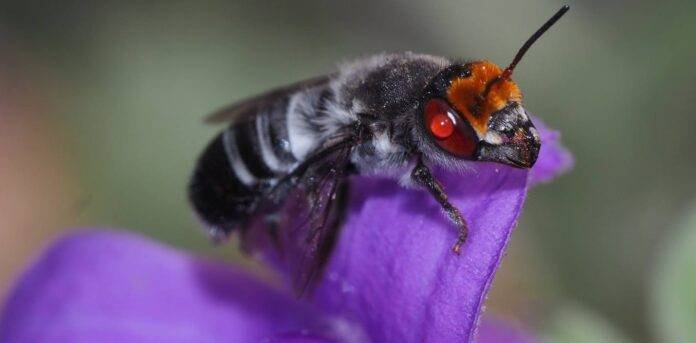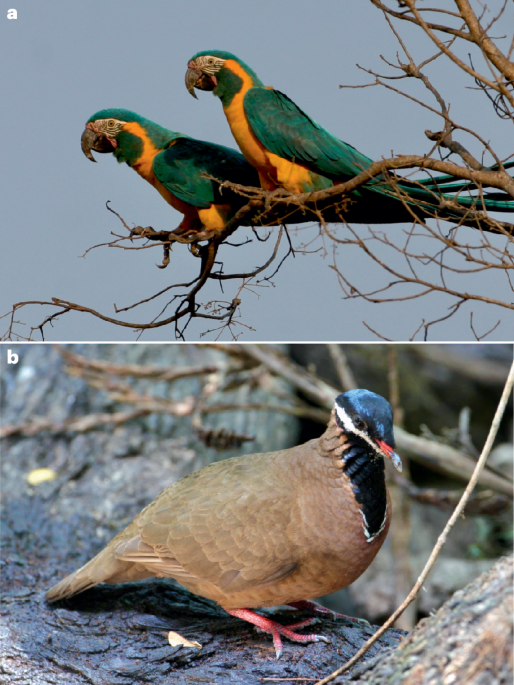Shmida, A. & Wilson, M. V. Biological Determinants of Species Diversity. J. Biogeogr. 12, 1 (1985).
Heino, J. et al. Metacommunity organisation, spatial extent and dispersal in aquatic systems: patterns, processes and prospects. Freshw. Biol. 60, 845–869 (2015).
Whittaker, R. J., Fernández-Palacios, J. M., Matthews, T. J., Borregaard, M. K. & Triantis, K. A. Island biogeography: Taking the long view of nature’s laboratories. Science https://doi.org/10.1126/science.aam8326 (2017).
Leibold, M. A. et al. The metacommunity concept: a framework for multi-scale community ecology. Ecol. Lett. 7, 601–613 (2004).
McGill, B. J. Matters of scale. Science 328, 575–576 (2010).
Patrick, C. J. & Swan, C. M. Reconstructing the assembly of a stream-insect metacommunity. J. North Am. Benthol. Soc. 30, 259–272 (2011).
De Araujo, L. I., Karsten, M. & Terblanche, J. S. Flight-reproduction trade-offs are weak in a field cage experiment across multiple Drosophila species. Curr. Res. Insect Sci. 3, 100060 (2023).
Mayfield, M. M. & Levine, J. M. Opposing effects of competitive exclusion on the phylogenetic structure of communities. Ecol. Lett. 13, 1085–1093 (2010).
Gerhold, P., Cahill, J. F., Winter, M., Bartish, I. V. & Prinzing, A. Phylogenetic patterns are not proxies of community assembly mechanisms (they are far better). Funct. Ecol. 29, 600–614 (2015).
Polis, G. A. & Strong, D. R. Food web complexity and community dynamics. Am. Nat. 147, 813–846 (1996).
Mertens, D., Bouwmeester, K. & Poelman, E. H. Intraspecific variation in plant-associated herbivore communities is phylogenetically structured in Brassicaceae. Ecol. Lett. 24, 2314–2327 (2021).
Bezemer, T. M. & van Dam, N. M. Linking aboveground and belowground interactions via induced plant defenses. Trends Ecol. Evol. 20, 617–624 (2005).
Leimu, R. & Koricheva, J. A meta-analysis of genetic correlations between plant resistances to multiple enemies. Am. Nat. 168. https://doi.org/10.1086/505766 (2006).
Wardle, D. A. et al. Ecological linkages between aboveground and belowground biota. Science 304, 1629–1633 (2004).
Ritchie, M. E. & Olff, H. Spatial scaling laws yield a synthetic theory of biodiversity. Nature 400, 557–560 (1999).
Rietkerk, M., Dekker, S. C., de Ruiter, P. C. & van de Koppel, J. Self-organized patchiness and catastrophic shifts in ecosystems. Science 305, 1926–1929 (2004).
Leibold, M. A. et al. The internal structure of metacommunities. Oikos 2022, (2022).
Harvey, E. & MacDougall, A. S. Trophic island biogeography drives spatial divergence of community establishment. Ecology 95, 2870–2878 (2014).
Stein, A., Gerstner, K. & Kreft, H. Environmental heterogeneity as a universal driver of species richness across taxa, biomes and spatial scales. Ecol. Lett. 17, 866–880 (2014).
Allouche, O., Kalyuzhny, M., Moreno-Rueda, G., Pizarro, M. & Kadmon, R. Area–heterogeneity tradeoff and the diversity of ecological communities. in. Proc. Natl. Acad. Sci. 109, 17495–17500 (2012).
McGill, B. J., Enquist, B. J., Weiher, E. & Westoby, M. Rebuilding community ecology from functional traits. Trends Ecol. Evol. 21, 178–185 (2006).
Wong, M. K. L., Guénard, B. & Lewis, O. T. Trait-based ecology of terrestrial arthropods. Biol. Rev. 94, 999–1022 (2019).
Gravel, D., Poisot, T., Albouy, C., Velez, L. & Mouillot, D. Inferring food web structure from predator-prey body size relationships. Methods Ecol. Evol. 4, 1083–1090 (2013).
Hillaert, J., Hovestadt, T., Vandegehuchte, M. L. & Bonte, D. Size-dependent movement explains why bigger is better in fragmented landscapes. Ecol. Evol. 8, 10754–10767 (2018).
Pincebourde, S., Dillon, M. E. & Woods, H. A. Body size determines the thermal coupling between insects and plant surfaces. Funct. Ecol. 35, 1424–1436 (2021).
Logghe, G. et al. Unravelling arthropod movement in natural landscapes: small-scale effects of body size and weather conditions. J. Anim. Ecol. 93, 1365–1379 (2024).
Futuyma, D. & Kirkpatrick, M. Evolution. (Oxford University Press, 2018).
Grafen, A. The phylogenetic regression. Philos. Trans. R. Soc. Lond. Ser. B, Biol. Sci. 326, 119–157 (1989).
Bonte, D. et al. Biomorphogenic Feedbacks and the Spatial Organization of a Dominant Grass Steer Dune Development. Front. Ecol. Evol. 9, 761336 (2021).
Huiskens, A. H. L. Ammophila Arenaria (L.) Link (Psamma Arenaria (L.) Roem. et Schult.; Calamgrostis Arenaria (L.) Roth). J. Ecol. 67, 363–382 (1979).
van der Putten, W. H. & Troelstra, S. Harmful soil organisms in coastal foredunes involved in degeneration of Ammophila arenaria and Calammophila baltica. Can. J. Bot. 68, 1560–1568 (1990).
McLachlan, A. Ecology of coastal dune fauna. J. Arid Environ. 21, 229–243 (1991).
Maes, D. & Bonte, D. Using distribution patterns of five threatened invertebrates in a highly fragmented dune landscape to develop a multispecies conservation approach. Biol. Conserv. 133, 490–499 (2006).
Bonte, D., Criel, P., Thournout, I. & Maelfait, J.-P. Regional and local variation of spider assemblages (Araneae) from coastal grey dunes along the North Sea. J. Biogeogr. 30, 901–911 (2003).
Ovaskainen, O. et al. How to make more out of community data? A conceptual framework and its implementation as models and software. Ecol. Lett. 20, 561–576 (2017).
Clark, J. S., Gelfand, A. E., Woodall, C. W. & Zhu, K. More than the sum of the parts: forest climate response from joint species distribution models. Ecol. Appl. 24, 990–999 (2014).
Thorson, J. T. et al. Joint dynamic species distribution models: a tool for community ordination and spatio-temporal monitoring. Glob. Ecol. Biogeogr. 25, 1144–1158 (2016).
Cavender-Bares, J. et al. Integrating remote sensing with ecology and evolution to advance biodiversity conservation. Nat. Ecol. Evol. 6, 506–519 (2022).
Provoost, S. & Bonte, D. Levende duinen, Een overzicht van de biodiversiteit aan de Vlaamse kust. 416 (2004).
Forey, E. et al. The relative importance of disturbance and environmental stress at local and regional scales in French coastal sand dunes. J. Veg. Sci. 19, 493–502 (2008).
Graveland, J. & Wal, R. Decline in snail abundance due to soil acidification causes eggshell defects in forest passerines. Oecologia 105, 351–360 (1996).
Bonte, D., Vandenbroecke, N., Lens, L. & Maelfait, J.-P. Low propensity for aerial dispersal in specialist spiders from fragmented landscapes. Proc. Biol. Sci. 270, 1601–1607 (2003).
Bonte, D., Baert, L., Lens, L. & Maelfait, J. Effects of aerial dispersal, habitat specialisation, and landscape structure on spider distribution across fragmented grey dunes. ECOGRAPHY 27, 343–349 (2004).
Didham, R. K. et al. Interpreting insect declines: seven challenges and a way forward. Insect Conserv. Divers. 13, 103–114 (2020).
Bonte, D., Lens, L. & Maelfait, J. P. Sand dynamics in coastal dune landscapes constrain diversity and life-history characteristics of spiders. J. Appl. Ecol. 43, 735–747 (2006).
MacArthur, R. H. & Wilson, E. O. The Theory of Island Biogeography. (Princeton University Press, Princeton, https://doi.org/10.1515/9781400881376 (1967).
Gravel, D., Massol, F., Canard, E., Mouillot, D. & Mouquet, N. Trophic theory of island biogeography. Ecol. Lett. 14, 1010–1016 (2011).
Van De Walle, R. et al. Arthropod food webs predicted from body size ratios are improved by incorporating prey defensive properties. J. Anim. Ecol. 92, 913–924 (2023).
Poggiato, G. et al. On the Interpretations of Joint Modeling in Community Ecology. Trends Ecol. Evol. 36, 391–401 (2021).
Vandegehuchte, M. L. M. L., de la Peña, E. & Bonte, D. Interactions between root and shoot herbivores of Ammophila arenaria in the laboratory do not translate into correlated abundances in the field. Oikos 119, 1011–1019 (2010).
Nickel, H. The Leafhoppers and Planthoppers of Germany (Hemiptera, Auchenorrhyncha): Patterns and Strategies in a Highly Diverse Group of Phytophagous Insects. (Pensoft Publishers, 2009).
Nartshuk, E. P. & Andersson, H. The Frit Flies (Chloropidae, Diptera) of Fennoscandia and Denmark. (Brill, 2013).
Chase, J. M. Community assembly: When should history matter? Oecologia 136, 489–498 (2003).
Fukami, T. Historical contingency in community assembly: integrating niches, species pools, and priority effects. Annu. Rev. Ecol., Evol. Syst. 46, 1–23 (2015).
Kaplan, I. et al. Physiological integration of roots and shoots in plant defense strategies links above- and belowground herbivory. Ecol. Lett. 11, 841–851 (2008).
Van De Walle, R., Massol, F., Vandegehuchte, M. L. & Bonte, D. The distribution and impact of an invasive plant species (Senecio inaequidens) on a dune building engineer (Calamagrostis arenaria). NeoBiota 72, 1–23 (2022).
Vandegehuchte, M. L. M. L., De La Peña, E. & Bonte, D. Contrasting covariation of above and belowground invertebrate species across plant genotypes. J. Anim. Ecol. 80, 148–158 (2011).
van der Putten, W. H. et al. Empirical and theoretical challenges in aboveground-belowground ecology. Oecologia 161, 1–14 (2009).
Nolet, C., Van, P. M., Suomalainen, J., Limpens, J. & Riksen, M. UAV-imaging to model growth response of marram grass to sand burial: Implications for coastal dune development. Aeolian Res. 31, 50–61 (2018).
Reijers, V. C. et al. Sediment availability provokes a shift from Brownian to Lévy-like clonal expansion in a dune building grass. Ecol. Lett. 24, 258–268 (2021).
Strypsteen, G., Bonte, D., Taelman, C., Derijckere, J. & Rauwoens, P. Three years of morphological dune development after planting marram grass on a beach. Earth Surfa. Processes Landforms 49, https://doi.org/10.1002/esp.5870 (2024).
van der Meulen, F., IJff, S. & van Zetten, R. Nature-based solutions for coastal adaptation management, concepts and scope, an overview. Nord. J. Bot. 2023, e03290 (2023).
Moran, P. A. P. Notes on Continuous Stochastic Phenomena. Biometrika 37, 17 (1950).
Bivand, R. & Wong, D. W. S. Comparing implementations of global and local indicators of spatial association. 716–748 https://doi.org/10.1007/s11749-018-0599-x (2018).
Michonneau, F., Brown, J. W. & Winter, D. J. an R package to interact with the Open Tree of Life data. Methods Ecol. Evol. 7, 1476–1481 (2016).
OpenTreeOfLife, B. R. et al. Open Tree of Life Synthetic Tree (12.3). Zenodo. https://doi.org/10.5281/zenodo.3937741 (2019).
Paradis, E. Klaus Schliep, ape 5.0: an environment for modern phylogenetics and evolutionary analyses in R. Bioinformatics 35, 526–528 (2019).
Ovaskainen, O. & Abrego, N. Joint Species Distribution Modelling: With Applications in R. (Cambridge University Press, https://doi.org/10.1017/9781108591720 2020).
Tikhonov, G. et al. Joint species distribution modelling with the R-package Hmsc. Methods Ecol. Evol. 11, 442–447 (2020).
Tikhonov, G. et al. Computationally efficient joint species distribution modeling of big spatial data. Ecology 101, 1–8 (2020).
Bjornstad, O. N. ncf: Spatial Covariance Functions. 1.3-2 https://doi.org/10.32614/CRAN.package.ncf (2022).
Schielzeth, H. Simple means to improve the interpretability of regression coefficients. Methods Ecol. Evol. 1, 103–113 (2010).
Bürkner, P., Gabry, J., Kay, M. & Vehtari, A. posterior: Tools for Working with Posterior Distributions. https://mc-stan.org/posterior/ (2025).
Plummer, M., Best, N., Cowles, K. & Vines, K. CODA: Convergence Diagnosis and Output Analysis for MCMC. R. N. 6, 7–11 (2006).
Vehtari, A., Gelman, A., Simpson, D. & Carpenter, B. Paul-Christian Bürkner “Rank-Normalization, Folding, and Localization: An Improved ˆR for Assessing Convergence of MCMC (with Discussion). Bayesian Anal. 16, 667–718 (2021).
Tjur, T. Coefficients of determination in logistic regression models – A new proposal: The coefficient of discrimination. Am. Stat. 63, 366–372 (2009).
Sofaer, H. R., Hoeting, J. A. & Jarnevich, C. S. The area under the precision-recall curve as a performance metric for rare binary events. Methods Ecol. Evol. 10, 565–577 (2019).
Poisot, T. Guidelines for the prediction of species interactions through binary classification. Methods Ecol. Evol. 14, 1333–1345 (2023).






